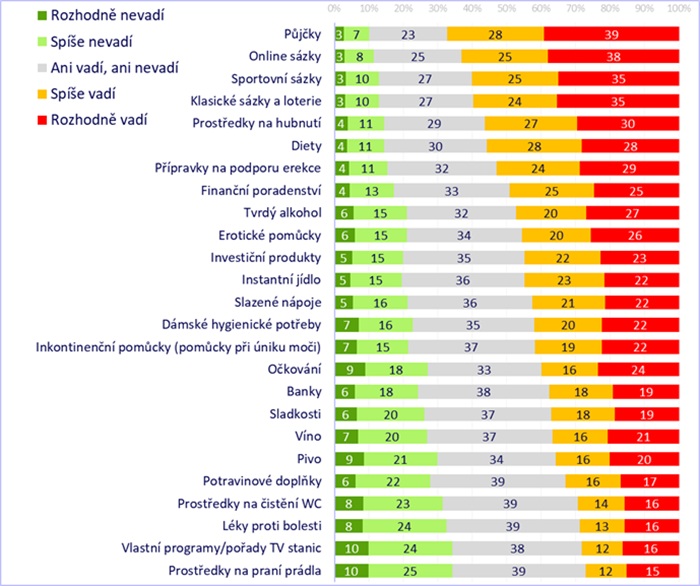Estimates of how many ads a person might see in a day, for example, vary widely, but are usually in the lower thousands per day at least (according to AI-powered internet search, the popular range is currently between four and ten thousand ads per day). Naturally, we only pay attention to a fraction of these, but even so, it's tens of ads a day that we pay some attention to (usually quoted in the hundreds).
For example, in the third week of June (16-22 June 2025), 221,391 ad spots were aired on 61 channels monitored in the Czech Republic alone (on channels financed by advertising).
But what do the Czechs actually think about ads and how do they perceive them?
WPP Media is certainly not the first to ask such a question. The Czech Marketing Company has been conducting research on Czechs and advertising since 1993. But we wanted to look at the matter from the perspective of a media agency.
Therefore, we were interested not only in how much advertising bothers people in individual media outlets, or which categories of goods and services the audience is already a bit fed up with. We also wanted to find out what Czechs think about the content of ads in terms of relevance - to what extent do they feel that ads are about people or for people like them? And can advertising overdo it, according to Czechs?
Before we move on to the results, just a quick update on where and how the data came from. We didn't do any extra research on this topic, but we added the questions as a supplement to the latest wave of our mPanel (WPP Media's own consumer panel). So we asked the online population of 15 Czechs numbering 5014 (that's not a mistake, it's the size of one wave of the panel, so the results are really "hard").
One more note: I'm only bringing a selection of the results, not the full data, that's already paid for..
What do Czechs think about the ads?
From the point of view of ad makers, it's probably pretty good news that most Czechs (73%) think advertising can be a bit over the top. 39% even strongly agree. And you won't find any major differences in this attitude between genders or Czechs of different ages.
37% of Czechs are informed by ads about new products, especially younger people, slightly more women and also those who are more affluent (AB in socio-economic classification). On the other hand, only 21% of Czechs think that advertisements force them to buy things they do not need (56% disagree and the rest have no opinion). Men are more likely to grumble about ads forcing them to buy unnecessary things - on the whole, regardless of age.
And only 14% of Czechs say ads negatively affect their self-esteem. If you'd expect more young people or women to say this, for example, not so much. There are almost no differences by gender or age. Something else has an impact here - what your income is. The negative impact of ads on self-esteem is mainly declared by people with lower incomes.
Czechs also don't feel strongly that there are too many stereotypes of women or men in ads. 24% think that there are stereotypes about men and 25% think that there are stereotypes about women (29% among women). There are almost no differences by age.
Perception of the world in advertisements
You may be starting to wonder who we were asking about the fact that everything is sunlit. So what causes this relative conciliationism?
A big factor is undoubtedly that half of Czechs say that the older they get , the more they feel that ads pass them by, so they don't pay attention to what you're trying to tell them. 45% of Czechs 15 (and across all ages) then believe that there are few characters in ads that they can identify with. The opposite, that is, that there are characters in them that they could identify with, is thought by only 16%.
And even fewer, only one tenth, of Czechs agree that there are people like them in commercials. In short, it's all about relevance. Yet, as we know from various pre and post tests (not only ours), relevance is one of the main conditions for effective advertising.
So how do Czechs perceive the cast of ads? According to a third of Czechs, there are too many handsome and rich people in ads. A quarter don't think so and the rest have no opinion. It is true that as you get older, either the ads go more and more beyond you and you don't care who is in them, or you start to get more annoyed. Then retirement is downright critical from that perspective (given the income dips). And, perhaps unsurprisingly, the lifestyle presented in the ads annoys lower-income Czechs more. Similarly, the lower the income, the more you feel that only the rich are in the ads.
Perceptions of advertisements for various goods and services
We also wanted to know how perceptions of advertising for different types of goods and services stood. We selected 25 of them. From those where we didn't expect any controversy (as a sort of benchmark) to those where we suspected it but wanted to have it measured.
The results ended up surprising us a bit. In fact, loans came out on top (as the most unpopular category) followed by online and/or sports betting and lotteries. These categories bother 60% or more of Czechs on average. And the dislike of these categories is shared by people regardless of age or gender. The top 3 unpopular categories are rounded out by weight loss or dieting products.
And which categories are "safe"?
Household drug products (laundry detergents, toilet cleaners, etc.), painkillers, food supplements, and even sweets. And yes, we're in the Czech Republic, so the categories with few objections include beer.
All is not lost for the banks either - as long as they promote their services in general (and not loans), they are more or less in the safe zone.
 Chart: To what extent do Czechs mind/not mind ads for different categories of goods and services; Source: WPP Media
Chart: To what extent do Czechs mind/not mind ads for different categories of goods and services; Source: WPP MediaIn general, younger people have fewer objections (except for the top 3 categories above, where it is the same for all). Conversely, the number of categories people have reservations about increases with age.
And who doesn't like loan ads? Well, pretty much everyone. Even most people who have loans or declare that they don't have that much of a problem borrowing don't like loan ads in their majority. Nor do they decide what bank people are clients of.
Who cares about weight loss ads? Strangely enough, those who are trying to lose weight repeatedly are more receptive to ads for diets or weight loss products (they mind them too, but to a lesser extent than those who are not trying to lose weight). So actually everything is more or less fine here, because the target group is relatively listening to what you say.
Similarly for categories like sweets or instant food. Both categories bother more those who declare that they are trying to eat healthy, watch what they eat, follow a healthy lifestyle. So again, from a communication point of view, everything is fine, because the target group of consumers does not make such a fuss about it.
What helps advertising to succeed?
We also had the luxury of asking people if they could think of any recent advertising that appealed to them and felt like it was about them. And conversely, whether they could recall any recent advertising that, while it was for goods/services they use, they found completely irrelevant.
Only 8% of Czechs could recall any recent advertising that spoke to them in any way (they found it relevant). Oddly, finance leads the way (but beware it is about bank services in general or insurance, investments - not loans). Alcoholic beverages and grocery stores follow. So what works? It won't be too revelatory, but the main thing is the specific offerings that just meet the needs. You can't go wrong if you also add wit/humour and a good cast. Don't underestimate the quality of the workmanship either - the prevailing view is that if a commissioning body blows off a production, how can they be trusted to make their goods/services worth anything. Oh, and some of that discount stuff will sting too.
On the other hand, a tenth of Czechs could recall a recent advertisement that they found completely irrelevant, even though they use the category of goods or services in question. Finance also leads here, but cars and cosmetics are close behind. The main and fundamental problem here is the irrelevant lifestyle that the product or service is presented as (from the demeanour and appearance of the presenters in the ad to its setting). The financial unavailability of the goods in the ad also plays a role, which is primarily the case with new cars.
Placement of advertising
We are not the first to find that there is a general negative sentiment towards advertising as such: most Czechs dislike or even outright hate it. But this is only part of the truth. There are big differences between the different media types.
Most people (54%) do not mind advertising in newspapers and magazines, and outdoor advertising does not evoke any fundamentally negative emotions compared to other media types. Influencers are still relatively well off (although overall negative attitudes are already slightly more prevalent - 60% are bothered to some extent).
At the other end of the spectrum is advertising on video platforms (YouTube), where almost 2/3 of Czechs are very bothered by advertising. Television is close behind, with 58% of those who find advertising on it very annoying or outright hate it. The negative top 3 is rounded off by advertising on the internet and/or social networks.
And why do ads (or more precisely, their placement) bother people? Because they restrict content consumption and delay, and thus are simply annoying.
So you might wonder if Czechs are willing to pay extra for ad-free content. Not really. 58% prefer to watch with ads but for free and 29% say they will pay extra for an ad-free version now and then (more likely the more educated and wealthy).
So, those who save money will see ads in three. Even so, just to be safe, think about the perception context of your category (in what context you are showing your product/service) and, most importantly, the relevance of the form and content of the communication.
With today's targeting and content creation/editing capabilities, increasing the relevance of form, placement and message is the way to blunt the Czechs' aversion to ads.
Petr Tomáš, Consumer Research Skillhead, WPP Media
Source: mediaguru.cz

